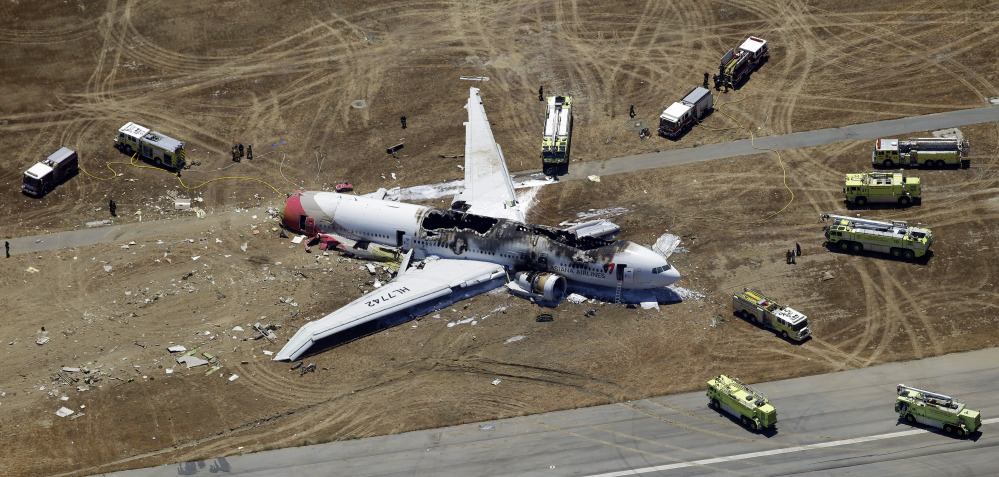WASHINGTON — The Asiana Airlines captain who crashed a Boeing 777 at San Francisco International Airport in July told investigators he was stressed out and “very concerned” about attempting a visual approach because the runway’s automatic warning systems were out of service due to construction, according to an investigative report released Wednesday.
Lee Kang Kuk, a 46-year-old pilot who was landing the big jet for his first time at San Francisco, “stated it was very difficult to perform a visual approach with a heavy airplane.” The jet crash landed after approaching low and slow in an accident that left three dead and more than 150 injured.
The report was released at the start of a daylong National Transportation Safety Board hearing into the accident.
“In this hearing, we will learn about the facts of the crash, but we will also learn about the factors that enabled so many to walk away. We will focus not only on the human machine interface in highly automated aircraft, but also on emergency response,” said NTSB Chairman Deborah Hersman, opening the hearing.
The trainee captain told investigators that he realized others had been landing at San Francisco without the glide slope indicator, a technology that helps pilots land at the airport. That system was out of service while the runway was expanded, and has since been restarted.
Interviews with the pilots who were in the cockpit indicated a nervous trainee captain, while the other two pilots recognized too late they were coming in too low and slow.
When asked if he was concerned about his ability to perform the visual approach, Lee said “very concerned, yea.”
A former Boeing 777 foreign captain at Asiana told investigators he found it “extremely difficult” to get pilots to fly visual approaches, and that they usually wanted to take off rather than land. In clear weather, it’s not unusual for pilots to make a visual approach, using the view through their windshield.
San Francisco Fire Department Assistant Deputy Chief Dale Carnes is also scheduled to talk at the hearing about how a fire truck racing toward the burning plane ran over a survivor on the tarmac.
Footage taken after the crash showed a fire truck running over 16-year-old Ye Meng Yuan while she was lying on the tarmac covered with fire-retardant foam. The San Mateo County coroner later ruled that she was killed by the truck.
Attorneys representing some of the more than 60 crash victims suing the airline and Boeing Co. plan to attend the hearing. Asiana Airlines is also offering $10,000 to each of the surviving passengers, a payout the airline says is not a settlement and does not prevent passengers from suing the airline.
The hearing was originally scheduled to run for two days, starting Tuesday, but it was postponed because of wintry weather in Washington, D.C. The crash was the first commercial airline crash in the U.S. since a crash near Buffalo, N.Y., in 2009.
Send questions/comments to the editors.



Success. Please wait for the page to reload. If the page does not reload within 5 seconds, please refresh the page.
Enter your email and password to access comments.
Hi, to comment on stories you must . This profile is in addition to your subscription and website login.
Already have a commenting profile? .
Invalid username/password.
Please check your email to confirm and complete your registration.
Only subscribers are eligible to post comments. Please subscribe or login first for digital access. Here’s why.
Use the form below to reset your password. When you've submitted your account email, we will send an email with a reset code.